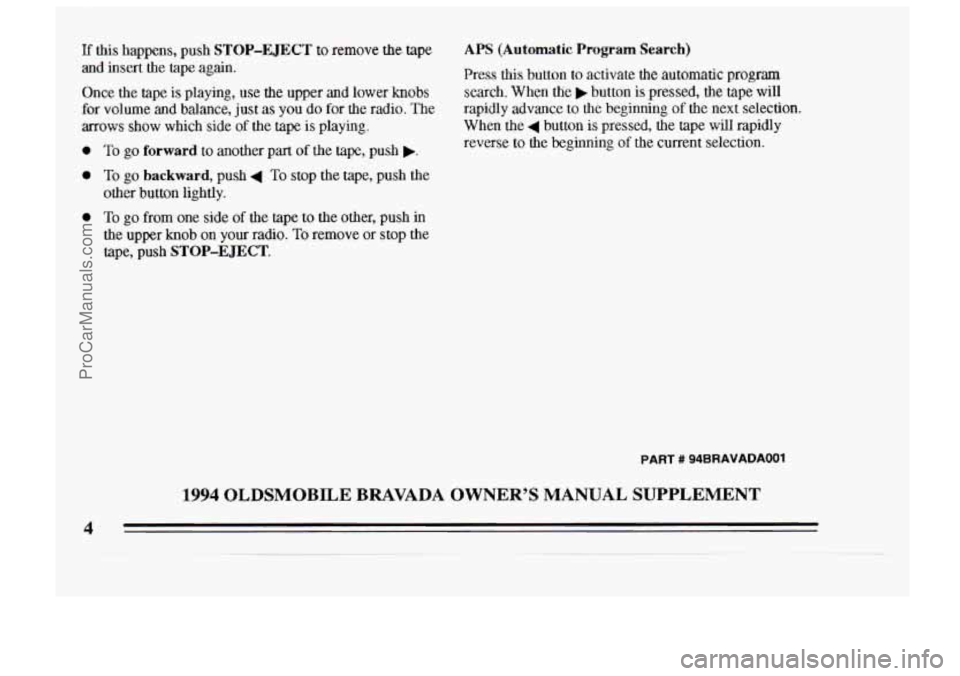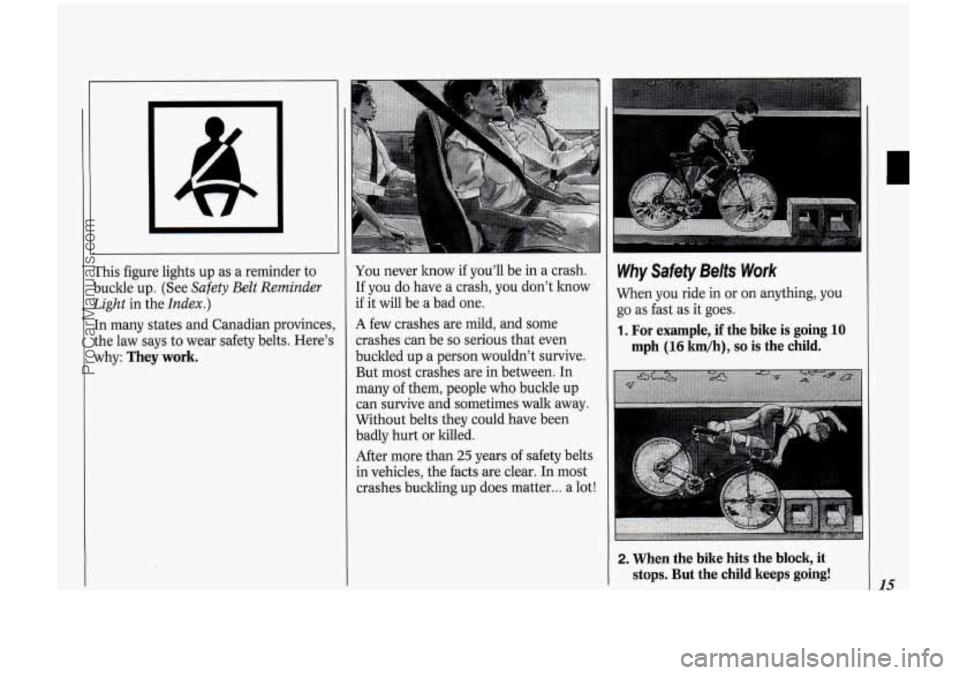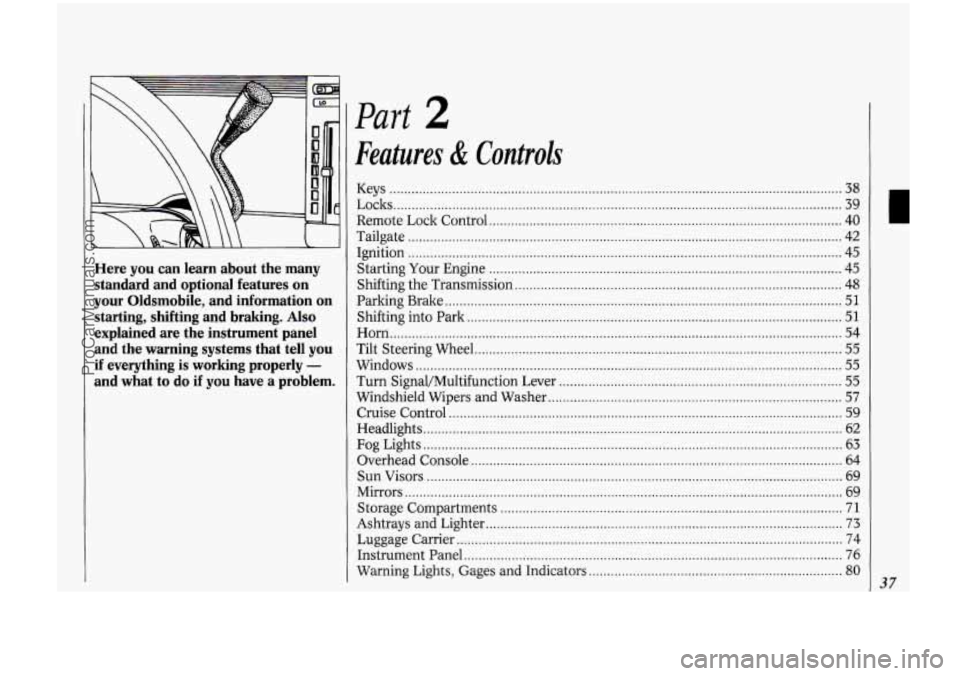light OLDSMOBILE BRAVADA 1994 Owners Manual
[x] Cancel search | Manufacturer: OLDSMOBILE, Model Year: 1994, Model line: BRAVADA, Model: OLDSMOBILE BRAVADA 1994Pages: 248, PDF Size: 14.54 MB
Page 6 of 248

If this happens, push STOP-EJECT to remove the tape
and insert the tape again.
Once the tape
is playing, use the upper and lower knobs
for volume
and balance, just as you do for the radio. The
arrows show which side
of the tape is playing.
0 To go forward to another part of the tape, push ..
0 To go backward, push 4 To stop the tape, push the
other button lightly.
0 To go from one side of the tape to the other, push in
the upper knob on your radio. To remove or stop the
tape, push
STOP-E JECT.
APS (Automatic Program Search)
Press this button to activate the automatic program
search, When the button is pressed, the tape will
rapidly advance to the beginning of the next selection.
When the
4 button is pressed, the tape will rapidly
reverse to the beginning
of the current selection.
ProCarManuals.com
Page 12 of 248

How to Use this Manual
MANY PEOPLE READ THEIR OWNER’S
manual from beginning to end when
they first receive their new vehicle.
This
vvlll help you learn about the
features and controls for your vehicle.
In
this manual, you’ll find that
pictures and words work together
to explain things quickly.
There are nine parts with thumb-
tabbed pages
in this manual.
Each part begins with
a brief list of
contents,
so you can usually tell at a
glance if that part contains the
information you want.
You can bend the manual slightly to
reveal the tabs that help you find
a
part.
6
Part 1: Seats & Restraint Systems
This part tells you how to use your
seats and safety belts properly.
Part 2: Features & Controls
This part explains how to start and
operate your Oldsmobile.
Part 3: Comfort Controls & Audio Systems
This part tells you how to adjust the
ventilation and comfort controls and
how to operate your audio system.
Part 4: Your Driving and the Road
Here you’ll find helpful information
and tips about the road and how to
drive under different conditions.
Part 5: Problems on the Road
This part tells you what to do if you
have
a problem while driving, such as
a flat tire or engine overheating.
ProCarManuals.com
Page 15 of 248

Vehide Symbols
These are some of the symbols you
will find on your vehicle. For
example, these symbols are used on
an original battery:
Caution Possible Injury
Protect Eyes by
Shielding
Caustic Battery Acid
Could Cause Burns
Avoid Sparks or Flames Spark or Flame Could Explode Battery A
8
These symbols are important for you
and your passengers whenever your
vehicle is driven:
Fasten Safety Belts
Door LocklUnlock
These symbols have to do with your
lights:
Master Lighting Switch
Turn Signal Direction
Hazard Warning Flashers
A
Headlight High Beam
Parking Lights
Fog Lights
pf
$0
ProCarManuals.com
Page 16 of 248

How to Use this Manual
These symbols are on some of your
controls: These symbols
are used on warning
and indicator lights: Here
are some other symbols you
may see:
Windshield Wipers
Engine Coolant
Temperature Fuse
w Windshield
Washer
Battery Charging
System Tailgate Window
Windshield Defroster Lighter
Fuel
Rear Window Defogger Horn
Speaker
Engine
Oil Pressure
Rear Window Wiper
Brake
Hood Release
Rear Window
WiperlWasher Anti-Lock Brakes
Ventilating Fan
Power Window
10
ProCarManuals.com
Page 21 of 248

El
This figure lights up as a reminder to
buckle up. (See
Safety Belt Reminder
Light
in the Index.)
In many states and Canadian provinces,
the law says to wear safety belts. Here’s
why:
They work.
You never how if you’ll be in a crash.
If you do have a crash, you don’t know
if it will be a bad one.
A few crashes are mild, and some
crashes can be
so serious that even
buckled up a person wouldn’t survive.
But most crashes are in between. In
many of them, people who buckle up
can survive and sometimes walk away.
Without belts they could have been
badly hurt
or killed.
After more than
25 years of safety belts
in vehicles, the facts are clear. In most
crashes buckling up does matter
... a lot!
Why Safety Belts Work
When you ride in or on anything, you
go as fast as it goes.
1. For example, if the bike is going 10
mph (16 km/h), so is the child.
2. When the bike hits the block, it
stops. But the child keeps going! 15
ProCarManuals.com
Page 23 of 248

With safety belts, you slow down as the
vehicle does.
You get more time to stop.
You stop over more distance, and your
strongest bones take the forces. That’s
why safety belts make such good sense.
HereAre Questions Many
People
Ask About Safety
Belts
- and the Answers
Q: Won’t I be trapped in the vehicle
after an accident if I’m wearing a
safety belt?
A: You could be - whether you’re
wearing a safety belt or not. But you
can easily unbuckle a safety belt,
even if you’re upside down. And
your chance of being conscious
during and after an accident,
so you
can unbuckle and get out, is much
greater if you are belted.
Q: Why don’t they just put in air bags
so people won’t have to wear safety
belts?
A: Air bags are in some vehicles today
and will be in more
of them in the
future. But they are supplemental
systems only
- so they work with
safety belts, not instead of them. Every
air bag system ever offered for
sale has required the use of safety
belts. Even if you’re in a vehicle that
has air bags, you still have to buckle
up to get the most protection. That’s
true not
only in frontal collisions, but
especially
in side and other
collisions.
drive far from home, why should I
wear safety belts?
A You may be an excellent driver, but
if you’re in an accident - even one
that isn’t your fault
- you and your
passengers can be hurt. Being a good
driver doesn’t protect you from
things beyond your control, such as
bad drivers. Most accidents occur
within
25 miles (40 lun) of home.
And the greatest number
of serious
injuries and deaths occur at speeds
of less than
40 mph (65 km/h).
Safety belts are for everyone.
Q: If I’m a good driver, and I never
Safety Belt Reminder Light
When the key is turned to Run or Start,
a light will come on for about eight
seconds to remind people to fasten
their safety belts. Unless the driver’s
safety belt is already buckled, a tone
will also sound.
17
ProCarManuals.com
Page 43 of 248

Here you can learn about the many standard and optional features on
your Oldsmobile. and information on
starting. shifting and braking
. Also
explained are the instrument panel
and the warning systems that tell you
if everything is working properly -
and what to do if you have a problem .
Part 2
Features & Controls
Keys ........................................................................\
.......................................... .. ....... 38
Locks ........................................................................\
.................................................. 39
Remote Lock Control
........................................................................\
........................ 40
Tailgate ........................................................................\
.............................................. 42
Ignition ........................................................................\
.............................................. 45
Starting Your Engine ........................................................................\
........................ 45
Shifting the Transmission ........................................................................\
................. 48
Parking Brake ........................................................................\
.................................... 51
Shifting into Park ........................................................................\
.............................. 51
Horn ........................................................................\
................................................... 54
Tilt Steering Wheel ........................................................................\
............................ 55
Windows ........................................................................\
............................................ 55
Turn Signal/Multifunction Lever ........................................................................\
..... 55
Windshield Wipers and Washer ........................................................................\
........ 57
Cruise Control ........................................................................\
................................... 59
Headlights
........................................................................\
.......................................... 62
Fog Lights ........................................................................\
.......................................... 63
Overhead Console
........................................................................\
............................. 64
Sun Visors
........................................................................\
......................................... 69
Mirrors
........................................................................\
............................................... 69
Storage Compartments
........................................................................\
..................... 71
Ashtrays and Lighter
........................................................................\
......................... 73
Luggage Carrier ........................................................................\
................................. 74
Warning Lights, Gages and Indicators
..................................................................... 80
Instrument Panel ........................................................................\
............................... 76
37
ProCarManuals.com
Page 48 of 248

Features & Controls
42
2. Lift the front cover off, bottom half
3. Remove and replace the batteries
4. Reassemble the transmitter.
5. Check the transmitter operation.
first.
(2016).
Theft
Vehicle
theft is big business, especially
in some cities. Although your
I Oldsmobile has a number of theft
deterrent features, we know that
nothing we put on it can make it
impossible to steal. However, there are
ways you can help.
Key in the Ignition
If you walk away from your vehicle with
the keys inside, it’s an easy target for
joy riders
or professional thieves - so
don’t do it.
When
you park your Oldsmobile and
open the driver’s door, you’ll hear a
tone reminding you to remove your key
from the ignition and take it with you.
Always do this. Your steering wheel
will be locked, and
so will your ignition
and transmission. And remember to
lock the doors.
Parking at Night
Park in a lighted spot, close all windows
and lock your vehicle. Remember to
keep your valuables out of sight. Put
them in a storage area, or take them
with you.
Parking Lots
If you park in a lot where someone will
be watching your vehicle, it’s best to
lock it up and take your keys. But what
if you have to leave your ignition key?
What
if you have to leave something
valuable
in your vehicle?
Put your valuables in a storage area,
like your glove box.
Lock the glove box.
Lock all the doors except the driver’s.
Then take the door key with you.
Tailgate Lock
From the outside, use the round key to
open the tailgate. With the key in the
lock, turn the lock handle to the left to
unlock the window.
Raise the window, then turn the lock
handle to the right to unlock the
tailgate.
ProCarManuals.com
Page 50 of 248

Features & Controls
44
Here’s How to Move the Arm:
1. Squeeze the release handle to free the
carrier arm.
2. Swing the carrier arm away from the
tailgate. You may need to give it a
slight tug.
To latch the carrier arm, swing it hard
toward the tailgate. The latch has one
catch,
so push hard on the carrier arm
to make sure it has locked in place. If it
is not securely latched, the carrier will
swing freely.
Glove Box
Use the door key to lock and unlock the
glove box. To open, pinch the latch
release.
New Vehicle “BreakmIn”
NOTICE:
Your modern Oldsmobile doesn’t
need an elaborate “break-in.” But it
will perform better in the long run
if you follow these guidelines:
Keep your speed at 55 mph (88
ltm/h) or less for the first 500
miles (804 ltm) .
Don’t drive at any one speed -
fast or slow - for the first 500
miles (804 ltm) . Don’t make full-
throttle starts.
Avoid malting hard stops for the
first
200 miles (322 lun) or so.
During this time your new brake
linings aren’t yet broken in. Hard
stops with new linings can mean
premature wear and earlier
replacement. Follow this
“breaking-in” guideline every
time you get new brake linings.
ProCarManuals.com
Page 51 of 248

U
Ignition Switch
With the ignition key in the ignition
switch, you can turn the switch to five
positions:
Accessory: An “on7’ position in which
you can operate your electrical power
xcessories. Press in the ignition switch
2s you turn the top of it toward you.
Lock: The only position in which you
:an remove the key. This locks your
steering wheel, ignition and
transmission.
Off: Unlocks the steering wheel,
ignition, and transmission, but does not
send electrical power to any accessories.
Use this position if your vehicle must be
pushed or towed, but never try to push-
start your vehicle. A warning chime will
sound if you open the driver’s door
when the ignition is off and the key is in
the ignition.
Run: An “on” position to which the
switch returns after you start your
engine and release the switch. The
switch stays in the
Run position when
the engine is running. But even when
the engine
is not running, you can use
Run to operate your electrical power
accessories, and to display some
instrument panel warning lights.
Start: Starts the engine. When the
engine starts, release the key. The
ignition switch will return to
Run for
normal driving.
Note that even if the engine is not
running, the positions
Accessory and
Run are “on” positions that allow you
to operate your electrical accessories,
such as the radio.
NOTICE:
If your key seems stuck in Lock
and you can’t turn it, be sure it is
all the way in.
If it is, then turn the
steering wheel left and right while
you turn the key hard. But turn the
key only with your hand. Using a
tool to force it could break the key
or the ignition switch. If none of
this works, then your vehicle needs
service.
Starting Your Engine
Move your shift lever to P (Park) or
N (Neutral). Your engine won’t start in
any other position
- that’s a safety
feature. To restart when you’re already
moving, use
N (Neutral) only.
NOTICE:
Don’t try to shift to P (Park) if your
Oldsmobile is moving. If you do,
you could damage the transmission.
Shift to
P (Park) only when your
vehicle is stopped.
45
ProCarManuals.com